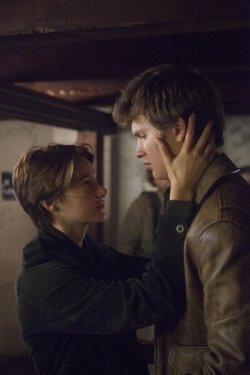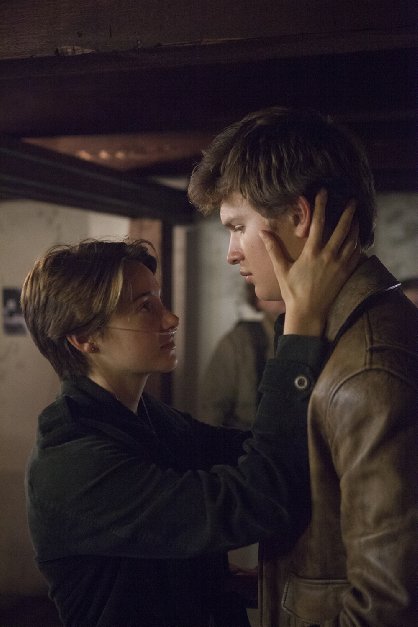Near the end of The Fault in Our Stars there's a scene in a church where three teenage "cancer kids" gather to perform a fake funeral, delivering eulogies for one another. One is blind, one's in a wheelchair, and one has an oxygen tank.
Each is keenly aware of their finitude and the reality of death. Each is familiar with suffering. Life is not as they wished it would be—but it is what it is.
The scene is a tearjerker but also breezy and funny, carrying both the horror of "oblivion" (as one character refers to it) and the ecstasy of life in one full heart. It's a tone that defines the movie generally. As a star-crossed teenage love story, it's neither too cynical nor too sappy. It's existentially burdened but also cheerfully in the moment, concerned with the biggest of questions but also (perhaps mostly) with the here and now.
 James Bridges / Twentieth Century Fox
James Bridges / Twentieth Century FoxThe film, directed by Josh Boone, is first and foremost a love story between Hazel Grace (Shailene Woodley) and Augustus (Ansel Elgort), teenagers with terminal cancer who meet in a support group. Much like last year's The Spectacular Now, which also starred Woodley, Stars captures beautifully the innocence and frailty of adolescent love, haunted as it is by the specter of impermanence. In this case the pressure of now is even greater, however, as death could come swiftly for either one of them.
At one point, the pair goes to Amsterdam for a Make-a-Wish-Foundation trip to visit the reclusive author (Willem Dafoe) of Hazel's favorite novel, An Imperial Affliction (an Infinite Jest-esque work). The connection between Hazel and Augustus is forged most deeply in this time abroad, in a way that reminded me a bit of Lost in Translation. Indeed, Sofia Coppola's 2003 film captured a mood of impermanence—a clinging to the "spectacular now" amidst the uncertainty, lost-ness, and frenetic pace of the technologized life—that resonated deeply with a generation and set the tone for post-9/11 cinema.
Our era is defined by what Douglas Rushkoff called "present shock." It's the most now-minded time in history, bound as we are to instant messaging, Insta-gram, 1-click shopping, and an always-on, live-streamed exposure to anything and everything happening now.
The "shock" of the present overwhelms us and leaves us longing for a bigger picture—those quaint relics we used to call metanarratives—or at least a cataclysmic ending, suggests Rushkoff, which is why apocalyptic and zombie media narratives are more popular than ever. Our awareness of death and the more-probable-than-ever demise of the planet (and in a weird way, our longing for it) leaves us with a #YOLO embrace of life while we have it.
Of course, this takes a few different forms. In a spate of recent films, Millennial YOLO life looks nihilistic, at best: Harmony Korine's Spring Breakers; Sofia Coppola's The Bling Ring; Gia Coppola's Palo Alto.
Thankfully The Fault in Our Stars presents a more nuanced and healthy manifestation of YOLO—one that is less oriented toward reckless self-gratification and more concerned with loving others.
 James Bridges / Twentieth Century Fox
James Bridges / Twentieth Century FoxStars is based on the best-selling book by John Green, a young adult fiction author who is also a "generational voice" of sorts, with a massive following on his YouTube vlog, Tumblr, and the like. He grasps the language, media habits, cynicism and idealism of Millennials in a way that feels neither awkward nor condescending.
In books like Stars, Green wagers that young people aren't just selfie-obsessed technology zombies, but people with souls and inklings toward the transcendent. His highly quotable writing is great fodder for inspirational tweets, Pinterest boards, and BuzzFeed lists, filling a need for a glimpse of some higher meaning amidst the maelstrom of over-mediation.
Green has made no secret of his Christian faith. Before he became a writer he wanted to be a minister. After studying literature and philosophy at Kenyon College, he applied to divinity school but instead got a job as a chaplain at an Ohio children's hospital.
During the six months that he worked there, Green struggled to reconcile the reality of evil with the ostensible omniscience of God. "All the reading I'd done, it meant nothing," he said in a recent interview. "No idea could hold up in the face of this reality. I was with actual children and actual families, and their kids were dying, and it was just devastating."
Stars is in part a film about this question of all questions: why does suffering exist, and why does it seem so arbitrary and unequally dispersed? The title is a nod to Julius Caesar ("the fault, dear Brutus, is not in our stars, but in ourselves") but an inversion of it. Green suggests that the "fault" is with the stars, or with God, and that it's a mystery and seeming injustice that we must accept. Why does someone like Anne Frank have to die so horribly and at such a young age? The film addresses the question directly when Hazel (in one of the film's more on-the-nose moments) visits the Anne Frank museum in Amsterdam.
And yet Stars doesn't get bogged down in theodicy. At the end of the day it accepts suffering as an inevitability of life, something that touches all, even the greatest men who ever lived. Even God.
It's no coincidence that in one of the earliest scenes of the film, a support group of sick teenagers meets in a church and sit in a circle surrounding a homemade "sacred heart of Jesus" rug. They've come together quite literally around the heart of Jesus, which is to say the heart of suffering. The scene made me think of Christian Wiman's My Bright Abyss, a book that also wrestles with the scourge of suffering, cancer and death but finds comfort in the cross.
"I am a Christian because of that moment on the cross when Jesus, drinking the very dregs of human bitterness, cries out, My God, my God, why hast thou forsaken me?" writes Wiman. "He felt human destitution to its absolute degree; the point is that God is with us, not beyond us, in suffering."
 James Bridges / Twentieth Century Fox
James Bridges / Twentieth Century FoxStars never touches the cross (or the resurrection) directly, even though Hazel and Augustus have vague conversations about God and the afterlife. On one hand it's a shame, given how profound it can be to have Christ with us in our suffering. Yet it also feels honest to where Hazel and Augustus are at and what they think they need. The abstractions of metaphysics and theology are no comfort in their final days; the tangible touch of a loved one is.
One of Hazel's key lines in the film is "some infinities are bigger than other infinities." It's her way of pointing out the incomprehensibility of what we call "infinity." We can't know such a thing in this life, at least not like we can know the now, the right in front of us. Yet something—our unquenchable curiosity, our soul's restlessness, the vastness of a star-filled sky—tells us we'll understand infinity one day.
Caveat Spectator
The Fault in Our Stars is rated PG-13 for some language, as well as one scene of sexuality involving teenagers (no nudity). A few scenes feature teenagers drinking and fake-smoking. The film's themes (namely: death, cancer, human finitude) are pretty heavy, but there's also plenty of humor to balance things out. In general it's a cleaner-than-average PG-13 film that depicts adolescents as more mature and innocent than we're used to seeing.
Brett McCracken is a Los Angeles-based writer and journalist, and author of the books Hipster Christianity: When Church and Cool Collide (Baker, 2010) and Gray Matters: Navigating the Space Between Legalism and Liberty (Baker, 2013). You can follow him @brettmccracken.












